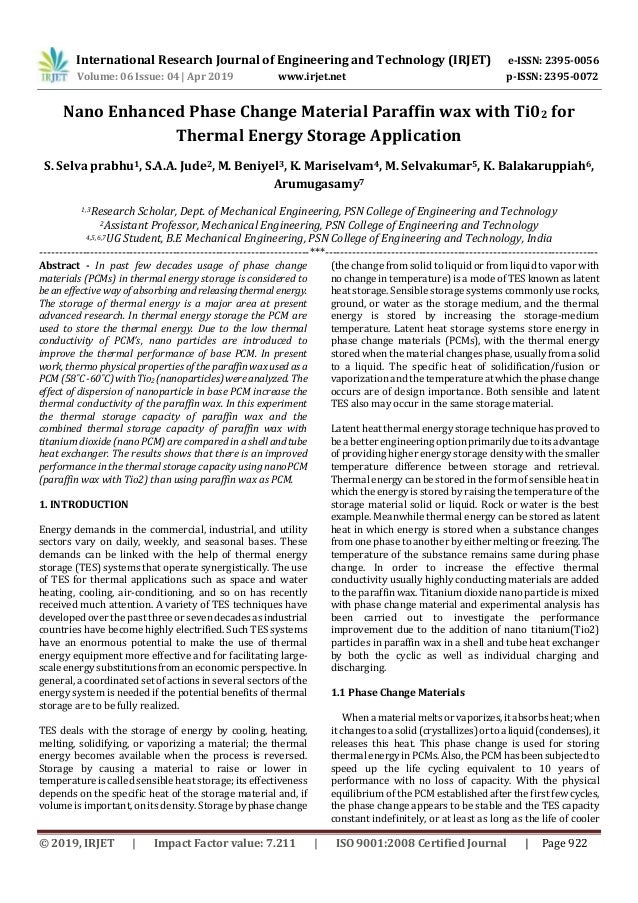- Aug 12, 2008 For beeswax, density ranges from 0.958 to 0.970 grams per cubic centimeter (g/cc). Parafin is about 0.93 g/cc. Carnauba wax runs about 0.97 g/cc. Aside from a number of synthetic waxes, there are.
- This leads me to the world of energy density. Are you familiar with it? It’s the amount of energy (calories) per unit of food. This is 200 calories of melon. This is a lot of melon. This is 200 calories of cheese. This isn’t very much cheese.
Water - Density, Specific Weight and Thermal Expansion Coefficient - Definitions, online calculator, figures and tables giving Density, Specific Weight and Thermal Expansion Coefficient of liquid water at temperatures ranging from 0 to 360 °C and 32 to 680°F - in Imperial and SI Units.
Thermal Investigation of Paraffin Wax for Low-Temperature Application
With this information I calculated the total energy released and the energy density of each fuel. My experiment showed that paraffin wax had the greatest energy density of the six fuels I tested, while wood had the lowest energy density. Paraffin wax, colourless or white, somewhat translucent, hard wax consisting of a mixture of solid straight-chain hydrocarbons ranging in melting point from about 48° to 66° C (120° to 150° F). Paraffin wax is obtained from petroleum by dewaxing light lubricating oil stocks. It is used in candles.
V. Karthikeya,Chatchai Sirisamphanwong,Sukruedee Sukchai
Abstract
Paraffin wax is an effective thermal energy storage material which changes solid to liquid phase during charging mode and liquid to solid phase for discharging mode. In this paper, two types of paraffin wax ; paraffin A and B were examined by accelerating the 100 thermal cycles; heating and cooling to verify the thermal stability and degradation mechanism of the thermal property. Digital scanning calorimetry (DSC) was used for both paraffin waxes in order to investigate the variation in melting temperature and latent heat of fusion in the 0th and 100th thermal cycle. Paraffin A and B melting temperature were stable in 0th and 100th thermal cycle as well as no noticeable variation on paraffin A latent heat of fusion in preliminary investigation whereas paraffin B showed wide variation in latent heat of fusion from 0th and 100th charging mode which was from 130.0 J/g to 203.0 J/g. It was a massive enhancement on energy density. The results showed that the paraffin B enabled high energy density than paraffin A. However, paraffin A latent heat of fusion remained stable during the investigation as well as relatively 0.02 g material evaporation was noticed. From this investigation, it was found that both paraffin wax were suitable for low thermal application.
Volume 11 | 05-Special Issue
Pages: 1437-1443
Energy Density Of Wax

Energy Density Of Wax Sticks
Abstract
The objective: The purpose of my project was to determine which fuel had the greatest energy density. I hypothesized that gasoline would have the greatest energy density because it is used commonly in many forms of transportation.Methods/Materials
In my experiment I used a home-made calorimeter to measure the energy of combustion for paraffin wax, gasoline, vegetable oil, diesel, sterno, and wood. A calorimeter is a device used to determine the amount of energy given off during a chemical reaction by measuring the change in temperature of water surrounding a reaction crucible. I recorded the starting temperature of the water and the mass of the fuel that I placed in the calorimeter. The fuel was lit and oxygen was circulated through the container. I sealed the crucible and placed it into a large bucket of water. After twenty minutes I stopped the experiment and measured the change in temperature of the water and the change in mass of the fuel. With this information I calculated the total energy released and the energy density of each fuel.
Results
Energy Density Of Wax Oil

My experiment showed that paraffin wax had the greatest energy density of the six fuels I tested, while wood had the lowest energy density.
Conclusions/Discussion
My conclusion did not support my hypothesis, although gasoline did have the second greatest energy density. This experiment shows that there is a significant difference between various fuels and suggests that in the future wax may become a more vital source of energy.
This project is about a calorimeter to determine the energy densities of six different fuels.
Science Fair Project done By Evan S. Stanford